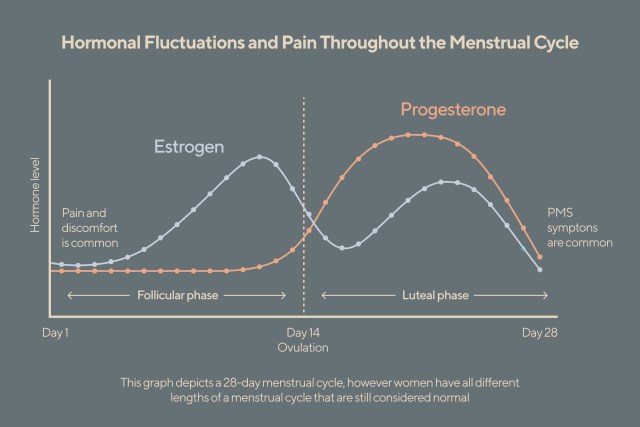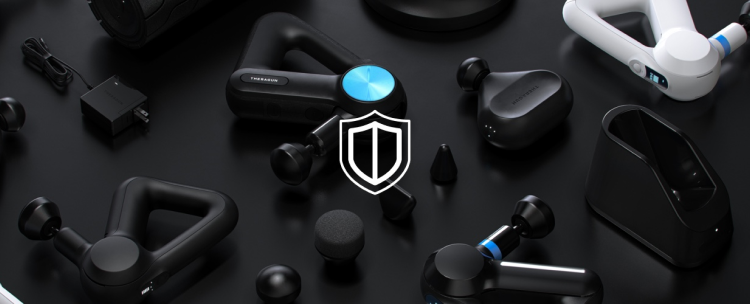Authors: Joshua Dexheimer, PhD and Nicole Strock, PhD
The menstrual cycle is an important indicator of overall health for women (it’s even considered the fifth vital sign). [1] And it’s thankfully getting its moment in the spotlight.
More and more women are aware that their menstrual cycle not only reveals a lot about their reproductive health, but also their day-to-day energy levels, food preferences, mood, and cognition (think brain fog). New technology is helping women better navigate the twists and turns of the menstrual cycle, with some devices helping track what cycle phase and even manage undesirable side effects like period pain.
But before jumping straight to the technology, it’s important to understand the four phases of the menstrual cycle, what’s really going on during your period, and why women experience period pain.
What Is the Menstrual Cycle?
The menstrual cycle refers to the sequence of hormonal events that occur within the body as it prepares for a possible pregnancy. [2] It starts on the first day of menses — your period — until the first day of your next period.
The length of this cycle varies for each person. It typically lasts an average of 28 days, but it’s normal to span anywhere from 21 to 35 days. [3] It’s composed of four distinct phases: the menstrual phase, follicular phase, ovulation phase, and luteal phase.
Each phase is driven by fluctuations in different sex hormones — namely estrogen, progesterone, luteinizing hormone (LH), and follicle-stimulating hormone (FSH). Shifts in these hormones can result in period-associated symptoms like bloating, headaches, and cramping. Here’s what goes on during each phase of a period.
Menstrual Phase
Your period is the first stage of the menstrual cycle when pregnancy doesn’t occur. Estrogen, progesterone, and luteinizing hormone levels drop, telling the uterus to shed the lining (of blood, tissue, and mucous) it built up to support a potential pregnancy.
Some women may experience period cramps and pain, mood swings, and tender breasts, whereas others seemingly glide through it. [4]
Follicular Phase
The follicular phase actually begins on the first day of your period (so there is some overlap in the timeline here). During this stage, an egg matures in an ovary, and an increase in estrogen tells the uterus to begin to prepare again for a potential pregnancy. On average, the follicular phase lasts about 16 days, ending with ovulation. [5]
Ovulation
When luteinizing hormone and a follicle reach their peak concentration in the body, they trigger ovulation — or the release of an egg from an ovary. The egg has about 12 to 24 hours to be fertilized, otherwise it dissolves. This is the point in the menstrual cycle where women are most fertile (or likely to become pregnant). Most women physically feel the best during this phase of the cycle — their mood is more positive, and symptoms are less present. [4]
Luteal Phase
Next is the luteal phase. During this time, the ruptured follicle (from which the egg was released) transforms into a structure called the corpus luteum. The corpus luteum produces the hormone progesterone that tells the uterus to keep prepping for a potential pregnancy (i.e., thickening the uterine wall). [6]
If fertilization of the egg does not occur, the corpus luteum breaks down, progesterone levels drop (as do estrogen levels), and then the cycle starts once again with menstruation.
The luteal phase is about 14 days and is the most notable time for premenstrual symptoms (PMS) like bloating, fatigue, irritability, feelings of anxiousness, and headaches. These symptoms can also run into the menstrual phase. [7]
Women often report the most severe mood and strongest PMS effects during either the luteal phase or menstruation. [4]

What Interferes With Your Menstrual Cycle?
Overall, your period is a barometer of your reproductive health. Having irregular periods (called oligomenorrhea) or losing your periods altogether (called amenorrhea) is your body’s way of saying something is not right. [8]
Here are some reasons people may experience irregular or absent periods:
- Stress: Stressful situations impact hormonal pathways in the body, altering the hormone levels that control the menstrual cycle. This can lead to irregular or missed periods or even more painful periods. [9]
- Energy deficiency: When you don’t consume enough calories on a daily basis (i.e., you burn more than you take in), your reproductive system becomes suppressed and can impact your period. [10, 11, 12]
- Underlying medical conditions: Certain medical conditions can also impact the presence or regularity of the menstrual cycle. These include premature ovarian insufficiency, disorders of the hypothalamus, pituitary gland or endocrine gland, polycystic ovary syndrome, or endometriosis. [13]
*Irregular or absent periods may require medical attention.
What Causes Pain During the Menstrual Cycle?
A healthy reproductive cycle can come with some not-so-comfortable side effects. Hormonal fluctuations during the different phases of the menstrual cycle can lead to pain and discomfort. Here are some reasons why this happens:
- During menstruation: Experiencing pain during the menstrual cycle is due to the production and release of prostaglandins (hormone-like compounds) just before and during your period. Specifically, these messengers reach the uterus and can cause blood vessels to constrict and stimulate the muscles of the uterus to contract, leading to the pain and cramping typically felt during the first several days of the period. [14]
- During ovulation: Some people can experience short-duration cramping or pain on one side of the lower abdomen just before and during ovulation. [15]
- During the luteal phase: Cramping and pain of the lower abdomen or lower back in the days leading up to your period are caused by the same prostaglandins that affect you during your period. [16]
Using technology to help manage discomfort
Luckily, there are powerful tools at our disposal, like transcutaneous electrical nerve stimulation (TENS), to target pain and discomfort throughout the menstrual cycle. It’s a non-invasive therapy that involves the use of low-voltage electrical impulses through electrodes placed on the skin near the area of pain. These impulses help reduce the pain signals to the brain, providing relief to the impacted area.
Therabody’s PowerDot 2.0 comes with a period pain relief program (via the PowerDot App) to help relieve period pain. You can place the electrodes wherever your discomfort is (like the lower abdomen or back).
If you’re one of the many people who experience cramping and pain during your menstrual cycle, try the PowerDot 2.0 Pro Bundle, which includes the Butterfly Back Pad, designed for lower back pain relief.
Key Takeaways
- While no person’s menstrual cycle completely mimics another, hormonal shifts indicate each of the four phases.
- Most people experience some side effects, including pain, from hormonal changes during the luteal or menstrual phase.
- Devices like Therabody’s PowerDot 2.0 can help provide some much-needed pain relief, such as on the lower abdomen and back.
- If your pain is debilitating or you are experiencing irregular (or missed) cycles, reach out to your healthcare provider.
*This article provides general information and discussions about health and related subjects. The information provided in this article and any linked materials are not intended for and should not be construed as medical advice, nor is the information a substitute for professional medical advice, diagnosis, or treatment.
References:
- https://pubmed.ncbi.nlm.nih.gov/33613678/
- https://www.ncbi.nlm.nih.gov/books/NBK500020/
- https://www.ncbi.nlm.nih.gov/books/NBK279054/
- https://pubmed.ncbi.nlm.nih.gov/37478677/
- https://www.ncbi.nlm.nih.gov/books/NBK542229/
- https://www.ncbi.nlm.nih.gov/books/NBK500020/
- https://www.sciencedirect.com/science/article/abs/pii/
- https://pubmed.ncbi.nlm.nih.gov/28368518/
- https://pubmed.ncbi.nlm.nih.gov/15758865/
- https://pubmed.ncbi.nlm.nih.gov/24463911/
- https://pubmed.ncbi.nlm.nih.gov/29773536/
- https://pubmed.ncbi.nlm.nih.gov/34164675/
- https://pubmed.ncbi.nlm.nih.gov/31259490/
- https://www.ncbi.nlm.nih.gov/pmc/articles/PMC7068519/
- https://pubmed.ncbi.nlm.nih.gov/31747229/
- https://www.ncbi.nlm.nih.gov/pmc/articles/PMC7068519/







